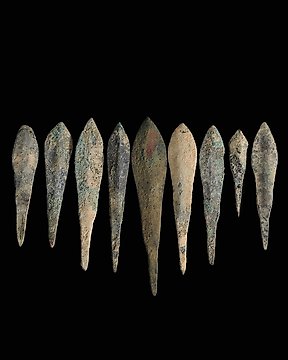
Anatolian Bronze Flat Arrowhead Group (9) (No Reserve Price)
No. 81555103

No. 81555103

A very fine bronze ‘Head of Christ’ Follis. The coin’s obverse depicts the bust of Christ holding the book of gospels. A nimbate cross is set behind his head, displaying a decorative motif to each limb. Part of the original inscription reading +EMMANOVHA is still visible around the top edge of the coin. The letters IC and XC are set in the field at either side of the bust to indicate the mint. The reverse reads the legend IS-XS BAS-ILE BAS-ILE to left and right above and below a on three steps. Written in Roman alphabet, the Greek inscription translates as ‘Jesus Christ, King of Kings’
The collapse of Iconoclasm during the mid 9th century AD initiated a gradual recovery of Byzantine religious art, which was testified on currency from the latter part of the reign of Michael II (842-67) by the use of the bust, or enthroned figure of Christ on the obverse of Constantinopolitan coins. Copper alloy pieces bearing such iconography, as seen on this example, appeared in the 10th century AD and became known as the ‘Anonymous Bronze Coinage’. First issued by John I, they replaced folles with imperial portraits, which were only reintroduced almost a century later by Constantine X (1059-67). The Christ/inscription in the four line design of the ‘Anonymous Bronze’ remained unchanged until AD 1028, when these types became increasingly varied, with some showing the bust or figure of the Virgin or a highly ornate cross. This piece dates to the joint reign of Basil II and Constantine VIII (AD 976-1028), under which the Byzantine State reached the zenith of its power.
Diameter: 2.6 cm
Weight: 10.46 g
Provenance: Ex Cambridgeshire private collection, acquired 1970s.
How to buy on Catawiki
1. Discover something special
2. Place the top bid
3. Make a secure payment